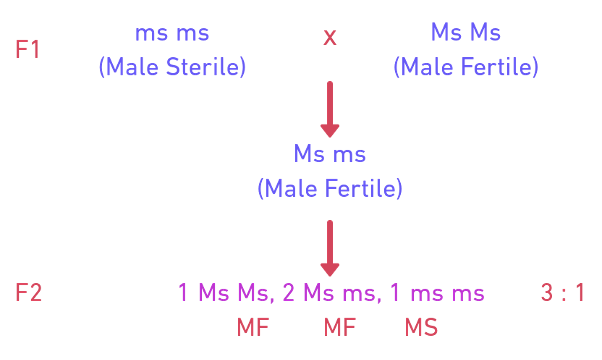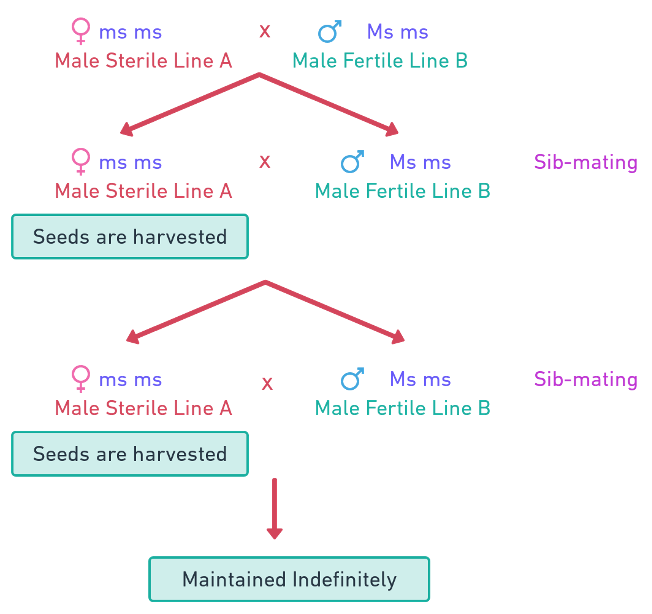🥶 Male Sterility
Learn abount Male Sterility
- Male sterility means
non-functionalpollen grains. Here female gametes are normally functional. It is classified into four groups: - Genetic Male Sterility (GMS) or Nuclear Male Sterility
- Temperature-sensitive GMS
- Photoperiod-sensitive GMS
- Transgenic GMS
- Cytoplasmic Male Sterility (CMS)
- Cytoplasmic-Genetic Male Sterility (CGMS)
- Chemically-Induced Male Sterility
- Male Sterility is used for hybrid seed production in many crops because it is a means of genetic emasculation. UPPSC 2021
Genetic (Nuclear) Male Sterility
- GMS/NMS is ordinarily governed by a single recessive gene
msbut also by dominant genes. Male sterility alleles are occurred spontaneously or are induced artificially. - Genetic male sterility is simple and ecofriendly technique of hybrid seed production. UPPSC 2021
- When a male sterile plant (ms ms) is crossed with the male fertile (Ms Ms) plant, the product F1 (Ms ms) is male fertile.
- In F2, 3 Fertile : 1 Sterile is obtained. A male sterile line is maintained by crossing with heterozygous male fertile (Ms ms). This mating produces 1 : 1 male sterile & male fertile plants.

Maintenance of a male sterile line

- During the maintenance of male sterile lines, sibmating (i.e. brother-sister mating) is achieved through natural pollination.
- In some cases ms gene expression is affected by the specified range of temperature and or photoperiod regime. Such GMS is environment sensitive and found in Rice, tomato, wheat etc.
- Temperature-sensitive Genetic Male sterility:
- Complete male sterility is produced by the ms gene at higher temperatures
- E.g. 23.3°C or higher for rice TGMS line Pei-Ai 645. This type of genetic male sterility is being used in the China to develop hybrid rice.
- Photoperiod-sensitive Genetic male sterility (PGMS):
- In some cases, ms gene expression is drastically affected by the prevailing photoperiod, provided the temp. is within the critical range.
- E.g. the critical temp. is 23-29° C for rice for PGMS. Within this critical temp. range, complete sterility is found in rice plants grown under long day conditions (i.e. day length more than 13 hours 45 minutes). But under short day conditions almost normal fertility is found. This type PGMS is being utilized in the China to develop hybrid rice.
Transgenic Genetic male sterility
- Transgene is such a gene which is introduced into the genome of an organisms by recombinant DNA technology or genetic engineering. Many transgenes cause male sterility. These are found in maize, cauliflower, tomato, wheat & chicory but this system is not yet used commercially.
- The genetic male sterility is being used for hybrid rice development in China. GMS is being successfully used in castor in U.S.A. In India GSM is being used for hybrid seed production of Arhar by private companies like Maharashtra Hybrid seed Co. Ltd.
Cytoplasmic Male Sterility (CMS)
- Here male sterility is governed by the cytoplasm. The male sterility is the result of mutation in the mitochondrial genome (mt DNA) which leads to mitochondrial dysfunction e.g. CMS-Maize, Ogura cms of brassica.
- Since the cytoplasm of a zygote comes primarily from egg cells, the progeny of such male sterile plants would always be male sterile.
- Cytoplasmic male sterility may be transferred easily to a given strain by using that strain as a pollinator (recurrent parent) in the, successive generations of a backcross programme.
- CMS is used only for the vegetative growth purposes because all the progenies are male steriles & there are no seed setting.
- It is used in chillies by some private companies.
- In 1996, Kaul concluded that restorer genes have been detected for all cases of CMS. The idea of CMS has been disfavored by Kaul and according to Kaul, male sterility is either genetic or cytoplasmic-genetic.

Cytoplasmic-genetic male sterility (CGMS)
- The case of cytoplasmic male sterility where the nuclear gene for restoring fertility in the male sterile line is known; is called cytoplasmic genetic male sterility.
- The fertility restorer gene, R, is dominant which restores male fertility in the male sterile line. If the nuclear genotype is rr, and the cytoplasm is male sterile, then plant would be male sterile.
- The effect of sterile cytoplasm is negated by the presence of restorer gene R even in heterozygous condition (Rr) because R is dominant over r.
- CGMS is also known as nucleoplasmatic male sterility.
- CGMS is commercially utilized in rice, wheat, maize, Sorghum, Perl Millet, Cotton etc.
- After selfing of the male fertile progeny, individual plant progeny is grown in the next generation and non-segregating progenies are selected and segregating progenies are rejected.
- Determination of genotype or genotypic value of a plant by studying its progeny is known as progeny test.

Chemical hybridising Agent (CHA)
- Such chemicals which affect the function of male reproductive organs in plants; are called chemical hybridising agents (CHAs).
- E.g.
Maleic hydrazide(MH),α - NAA,β - NAA, FW 450 (Mendok),Ethrel (Ethephon),Arsenicals, GA3, Hybrex (RH0007), Shell (WL 84811). Firstly in 1950, Moore & Naylor induced male sterility in maize using MN. - Hybrex has been used for the commercial production of hybrid wheat in USA since 1982.
- Arsenic inhibits respiration in anthers via enzymes like succinate dehydrogenase and cytochrome oxidase.
- Ethephon (Ethrel) produces ethylene which interacts with the plant hormone system.
- GA produces male sterility in rice, wheat etc. by interfering with tile nutrient flow to developing anthers.
- Hybrex disrupts pollen development during microsporogenesis which leads to irregular and thinner deposition of exine and ultimately to pollen
- Male sterility means
non-functionalpollen grains. Here female gametes are normally functional. It is classified into four groups: - Genetic Male Sterility (GMS) or Nuclear Male Sterility
- Temperature-sensitive GMS
- Photoperiod-sensitive GMS
- Transgenic GMS
- Cytoplasmic Male Sterility (CMS)
- Cytoplasmic-Genetic Male Sterility (CGMS)
- Chemically-Induced Male Sterility
- Male Sterility is used for hybrid seed production in many crops because it is a means of genetic emasculation. UPPSC 2021
Genetic (Nuclear) Male Sterility
- GMS/NMS is ordinarily governed by a single recessive gene
msbut also by dominant genes. Male sterility alleles are occurred spontaneously or are induced artificially. - Genetic male sterility is simple and ecofriendly technique of hybrid seed production. UPPSC 2021
- When a male …
Become Successful With AgriDots
Learn the essential skills for getting a seat in the Exam with
🦄 You are a pro member!
Only use this page if purchasing a gift or enterprise account
Plan
Rs
- Unlimited access to PRO courses
- Quizzes with hand-picked meme prizes
- Invite to private Discord chat
- Free Sticker emailed
Lifetime
Rs
1,499
once
- All PRO-tier benefits
- Single payment, lifetime access
- 4,200 bonus xp points
- Next Level
T-shirt shipped worldwide

Yo! You just found a 20% discount using 👉 EASTEREGG

High-quality fitted cotton shirt produced by Next Level Apparel